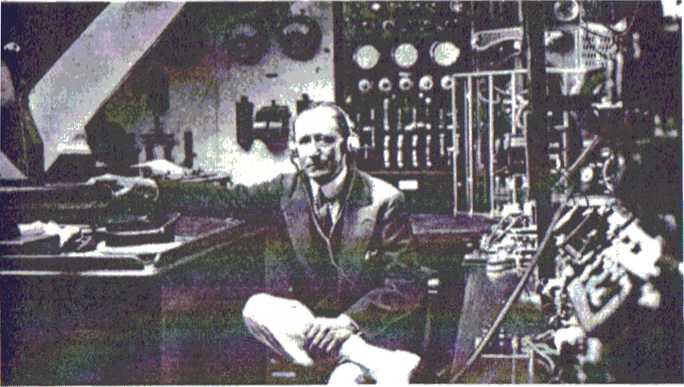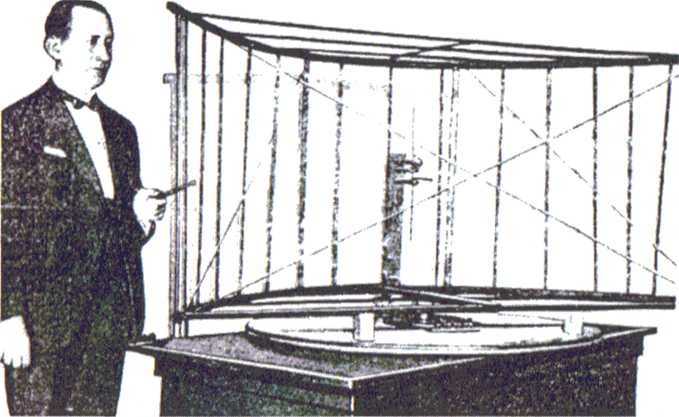Marconi eventually explored short and ultra short waves which were best suited for ionospheric bouncing. Bouncing these signals off the ionospheric
“ceiling” made long range communication possible. Ever the master of adaptation, Marconi utilized the new and special vacuum electron tubes to both generate and amplify signals. Vacuum triode tubes, the development of Lee De Forest, made shortwave possible, eUminating the need for large systems. In both his shortwave transmitters and receivers, these vacuum tube components produced amazing results. With a vacuum powered transmitter package no larger than a dresser bureau, one could broadcast vocal messages across the sea! Sheer magick. Marconi developed and popularized short alternating waves for public access, opening the wave world of High Frequency, Very High Frequency, and Ultra High Frequency to amateurs. Here was a great idea. But it was not really new. Tesla had spoken of it years before.
Marconi’s desire to make transoceanic travel safe and trouble free became a reality. He succeeded in perfecting a number of directional beam transmitters and detectors. With these beacons it was possible to pinpoint a ship on the ocean with great precision. Furthermore, using the sky as a reflective layer, ships could remain in exceedingly long distance communications with relatively compact vacuum tube equipment. The perfection of radiotelephonic transmitters and receivers became routine applications of this new communications art. The rapid deployment of highly commercialized shortwave radios everywhere filled the world with radio enthusiasts. Anyone could now transmit and receive signals, an impossibility vith the mammoth VLF systems on which he had too long expended his labors (see figure).
From the very moment in which he began these VHF and UHF experi

Ments, Marconi noticed the powerful effects which the environment exerted on his shortwave signals. Maritime shortwave sets were cdready becoming the standard navigational tools of every seagoing vessel. With the excessive reliance on these new vacuum tube powered compacts, new phenomena began to be a common feature of radiotelephonic signalling. Operators began recognizing radio “hot spots” and “dead spots” all over the world. Soon thereafter, strange maps of these variable reception zones were made for the wireless operators of seagoing vessels. These revealed travel arcs across the seas, and the expectable signal variables at each point. Other maps were constructed for the express purpose of outlining the various “silent zones” othervrise known as “blindspots”. Geologically incapable of finding any discernible pattern in these, the task of mapping such HF and VHF variables was left to empirical discovery (see figure).
This study acquired for itself a vast and fascinating cartography. Locations

Such as the Amazon were noted for their complete fade-out zones, points being reached on the otherwise sea level route where ships in sight of one another were xmable to communicate with wireless apparatus. These “screening effects” were also mysteriously found in certain regions out at sea. One famous natural screen was Gibraltar. Not one physicist was able to properly explain these inconsistencies. Each theoretical formulary, each “propagation law” failed at certain locations and with certain frequencies. The problem with theoretical propagation studies was that their perspectives took place in a thought realm and not in the biodynamic continuum, a matrix which thoroughly permeated geological structures adding horizons and topographies all its own. Where this biotopographic landscape met the surface, strange anomalies were observed in ground or aerial linked electrical apparatus.
An incredible new conception in radio broadcasting gradually began taking shape after Dr. Lee De Forest began making daily broadcasts of music, news, weather, time, and anecdotes from his small vacuum tube powered shortwave station KDKA. Soon, the entire nation and finally the world caught onto this broadcasting fad, a conunerdal deployment on such a far reaching level that even Marconi was surprised. This novelty surpassed his wildest hopes and dreams. Manufacturers now conceived the production of small radiowave receivers for the household, items which sold faster than their suppliers could fill orders.
With his shortwave transmitters and receivers, Marconi successfully saw the popularization of radio, a reality of which he had not previously dreamt. The gigantic bent-L aerials now were miniaturized, so that amateurs the world over could intercommunicate freely. With HF, VHF, and UHF, Marconi escaped his Morgcm entanglements. He made more money on shortwave systems than with all of his VLF stations combined. Eventually selling these rights to the Rockefeller owned RCA, Marconi managed to secure the advancement of shortwave to the world. In the inventive sciences, Marconi must remain a minor figure. With shortwave radio, Marconi believed that he had at last undone the monopoly which his principle financier had secured through highly privatized VLF stations. Despite this elevating fact, Marconi had never strayed far from his original wave technology, a tragedy which extended the example of tui inferior science and technology to every learning institute vaguely involved in the sciences. Also, the regulatory grip which once latched itself so voraciously onto VLF now appeared in another form. The FCC was developed to monitor, regulate, and otherwise police the new Radio Empire which shortwave opened to the great world public. Through this means, a new democratization process had asserted itself against the privatized VLF radio system.
Shortwave became a worldwide passion. Shortwave groups began appearing everywhere, in every nation. Soon, a vast consortium of wireless operators began bridging gaps between ordinarily impenetrable barriers of ethnicity and nationalism. A working class tide of world citizens began sharing a succinct new consciousness, one which recognized no geopolitical differences. Despite its complete inefficiency, and unfortunate in its newfound popularity as compared to a far better Teslian system, the shortwave revolution did indeed short circuit the firm geopolitical grip which had so isolated and limited working class civilians. Constrained to their work schedule, a population of labor and toils, shortwave pierced the invisible walls on which Oligarchic Houses so depended. People of every land, color, language, and religion found each other once again; an international guild of communicating souls, who shared a common and mysterious consciousness. Stars flickering in a sapphire sky, the ionospheric winds sang their sagas through the earphones of enthralled experimenters, who looked out at their aerials from solitary attic windows.
In the financial application, the commercialization of communications sys-terns, Marconi is the principle showman. Despite the woeful fact that the mere mention of the Marconi name is synonymous with “Radio”, “Wireless”, and indeed of “Global Communication”, history shows that Marconi was a far more successful businessman than an original discoverer of new electrical phenomena. Marconi was only original when he found himself in a position to apply what had been discovered by others. Somehow, he could never comprehend why his first experiments were so successful. Lacking the great power of his VLF mammoths, there was a sense that sparks did hide some unbelievable secret. Marconi’s method was not to back track his work as far as Tesla would have insisted, a complete revision of radiant mode. Years later, an aged Nikola Tesla was employed by RCA, the Rockefeller megalith, to make significant corrections on the Marconi Wave Radio System.
It is indeed unfortunate that Guglielmo Marconi was actually prevented fi-om achieving that true originality by which legends are known and remembered. Money and the advantage of noble birth remained his principle obstacles. Because he was financially equipped and socially privileged, he found himself ruling the fate of worlds. Lacking the appropriate knowledge, the position brought forth significant and damaging deviations fi-om the path of natural discovery. In his life, the inner blessing of vision never fully blossomed. He was a tragic figure, a sad statement concerning fame and technology. Marconi was a red rose frozen white in the snow. However Marconi tried to atone for his horrible actions in previous years, he was never able to clearly see the very first mistake which he had made. It began when he sent his first little wireless waves across his attic laboratory. Waves were the problem. Waves are still the problem.




 World History
World History


![Stalingrad: The Most Vicious Battle of the War [History of the Second World War 38]](https://www.worldhistory.biz/uploads/posts/2015-05/1432581864_1425486471_part-38.jpeg)






